So ive been trying something new
So, ive been trying to make my cockpits more realistics (Working cockpit instruments). and im not sure if im doing it the right way. But hey, new plane. I hope you like it and please leave a lik ---- hell no im not that kind of person, but please leave criticism or the things i should try to improve on. So back to the plane.
Changing of guard.
With the success of the former LRF-135 with their carrier service, the Self Defence Fleet Air Service wanted a replacement, and they did alert the designers over at Poyasakai to start development when the LRF-133 was introduced in service. They have learned many things with the LRF-133, one of it being the question about range. They asked the design bureau to scale back on the range, but to improve on other things, such as survivability and speed. What came next was a unique fighter.
Characteristics
The LRF-135 was still a long ranged fighter, but it has more armament options than the older 135. It was able to carry around a 1.3t torpedo, the same weight in bombs or 1 massive fuel tank. The LRF-135 also had a new engine, this engine can bring it up to 400+ kph at low altitudes, and almost the same in higher altitudes. However, the best suite of this plane can be extracted at sea level to medium altitude.
Controls
VTOL down - flaps
Activate 5 - arrestor gear
Activate 7 - fold wings
Also, it has high AoA so there that.
Specifications
Spotlights
- masotan15 3.7 years ago
- Bernkastel 3.4 years ago
General Characteristics
- Predecessor Poyasakai LRF-135-II Fighter
- Created On Windows
- Wingspan 42.3ft (12.9m)
- Length 35.6ft (10.8m)
- Height 14.6ft (4.4m)
- Empty Weight 7,605lbs (3,449kg)
- Loaded Weight 12,063lbs (5,471kg)
Performance
- Horse Power/Weight Ratio 0.215
- Wing Loading 32.0lbs/ft2 (156.3kg/m2)
- Wing Area 376.8ft2 (35.0m2)
- Drag Points 2406
Parts
- Number of Parts 1132
- Control Surfaces 2
- Performance Cost 3,434





Nice